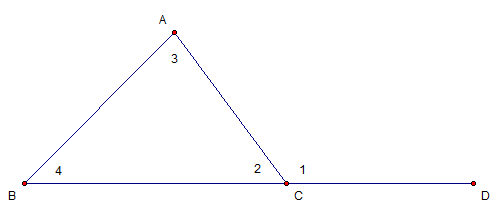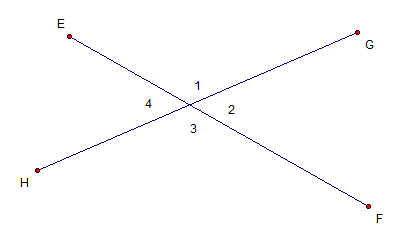Theorems
From MHSHS Wiki
(→Vertical Angle Theorem) |
(→Vertical Angle Theorem) |
||
| Line 43: | Line 43: | ||
==Vertical Angle Theorem== | ==Vertical Angle Theorem== | ||
| + | ===Vertical angles are equal=== | ||
Look at the intersecting line segments EF & GH below. We know that <math>\angle 1 + \angle 2 = 180^\circ</math> since they're supplementary angles. We also know that <math>\angle 1 + \angle 4 = 180^\circ</math> because they too are supplementary. If that's the case, it must be true that <math>\angle 2 = \angle 4</math> by substitution. | Look at the intersecting line segments EF & GH below. We know that <math>\angle 1 + \angle 2 = 180^\circ</math> since they're supplementary angles. We also know that <math>\angle 1 + \angle 4 = 180^\circ</math> because they too are supplementary. If that's the case, it must be true that <math>\angle 2 = \angle 4</math> by substitution. | ||
| - | By the same logic, <math>\angle 1 = \angle 3</math> | + | By the same logic, <math>\angle 1 = \angle 3</math>. Angle 2 and angle 4 are vertical angles, and angle 1 and angle 3 are also vertical angles. |
[[File:Vertical_angles.gif|Vertical angles]] | [[File:Vertical_angles.gif|Vertical angles]] | ||
Revision as of 01:18, 21 October 2009
The Distance Formula

Example: Find the distance between point A(5,-7) and B(-6,-2) and leave your answer in radical form.
Solution: Let A be point 1 and B be point 2. We have 
Substituting we have 
Try some distance problems at Distance & Midpoint 9-2 ME Worksheet
Sum of the Sides of a Triangle
Thm: The sum of two sides of any triangle must be greater than the third side
Example: Given two sides of a triangle are 8 inches and 11 inches, find all the possible lengths of the third side (also known as S3)
Solution: Since we know that 8 + 11 must be greater than S3, we have  ,
so S3 must be less than 19. But what is the smallest value that S3 can be?
,
so S3 must be less than 19. But what is the smallest value that S3 can be?
Well, we know that  , but 11 is already greater than 8 so that doesn't help us.
However we also know that
, but 11 is already greater than 8 so that doesn't help us.
However we also know that  .
.
Using algebra we subtract 8 from both sides of our inequality we get  , so
, so  . Our final answer is
. Our final answer is  (our third side must be greater than 3 but less than 19).
(our third side must be greater than 3 but less than 19).
External Angle Theorem
Thm: An external angle is equal to the sum of the two opposite interior angles.
Look at the figure below. We know that the sum of the interior angles of a triangle is 180 degrees. That means that
in triangle ABC below,  . We also know that angles 1 and 2 are supplementary angles, meaning that
. We also know that angles 1 and 2 are supplementary angles, meaning that  .
So if
.
So if  and
and  , then it must be true that
, then it must be true that  by substitution.
by substitution.
Vertical Angle Theorem
Vertical angles are equal
Look at the intersecting line segments EF & GH below. We know that  since they're supplementary angles. We also know that
since they're supplementary angles. We also know that  because they too are supplementary. If that's the case, it must be true that
because they too are supplementary. If that's the case, it must be true that  by substitution.
By the same logic,
by substitution.
By the same logic,  . Angle 2 and angle 4 are vertical angles, and angle 1 and angle 3 are also vertical angles.
. Angle 2 and angle 4 are vertical angles, and angle 1 and angle 3 are also vertical angles.


